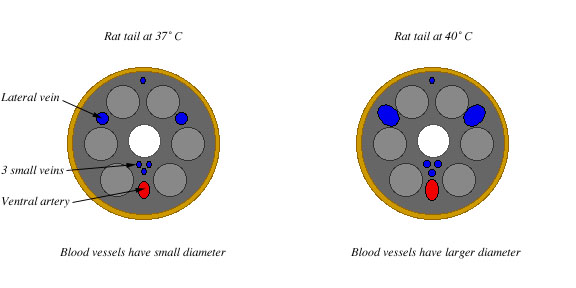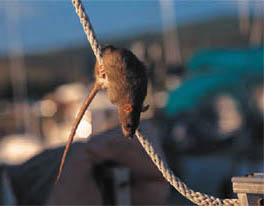What are the parts of the rat's tail?
The rat's tail is an extension of the vertebral column that projects out the back side of the animal. The tail is a long cylinder consisting of three concentric layers. The innermost core of the tail is bone (vertebre). The bone is surrounded by a layer of tendons, and the tendons are surrounded by a layer of skin. Blood vessels run the length of the tail between the tendons.

Cross-section of a rat's tail. Drawing adapted from Vanhoutte et al. 2002
What are the functions of the rat's tail?
The rat's tail has a thermoregulatory function: it serves as a heat-loss organ. The tail is well suited for this purpose, because it has no fur, has a large surface to volume ratio, and is perfused with many blood vessels, especially at the tail tip and midlength (Yulong et al. 1995). The rat's tail comprises only 5% of the rat's surface area, but it can dissipate about 17% of the rat's body heat (Monson and Oyama 1984).
Rats control their body temperature through their tails by dilating or constricting their tail blood vessels. When the rat's body temperature rises by a few degrees, the tail vessels (especially the veins) swell -- called vasodilation -- permitting lots of warm blood to flow through the tail (Vanhoutte et al. 2002). The warm blood loses heat through the surface of the tail and returns to the body at a lower temperature, thus cooling the rat. The warmer the rat, the more blood flows through the tail, and the more heat is lost (Thompson and Stevenson 1965, Little and Stoner 1968, Rand et al. 1965, Raman et al. 1987).
When the rat's body temperature drops, the tail vessels shrink in diameter -- called vasoconstriction -- thus restricting blood flow to the tail (Owens et al. 2002). Less blood flows into the tail for cooling, and body heat is conserved.

Cross section of the base of a rat's tail at two different body temperatures (37º and 40º C). At 40º C, the diameter of the blood vessels (especially the veins) is larger than at 37º C. This larger diameter permits more blood to flow through the tail: 15% more blood flows through the arteries and 125% more flows through the veins at 40º C than at 37º C. Adapted from Vanhoutte et al. 2002.
Balance
Rats use their tails for balance. They climb ropes and anchor chains, they walk along fences and telephone wires and branches, and their tails help them balance.

The tail can also help change the center of gravity of the rat, though this change will remain small because the tail weighs so little. In the photograph to the right, the rat is holding on to the rope with his hind legs, and his forequarters and tail are hanging below and to either side of the rope. The rat's center of gravity is low and close to the rope. A low center of gravity makes balancing easier, because a larger rotation is required to tip the rat over.
|
|
Further reading:
- physics of high wire acts
- center of gravity, balance, and sports
- SMILE exercise on center of gravity
Tailless Rats
Note: I am a biologist, not a rat breeder, therefore, this is not a section about tailless rats as pets. This is an article about tailless rat biology.
There are at least two mutations that cause taillessness in rats: Tail-anomaly lethal (Tal) and stub (st).
• Tail-anomaly lethal (Tal): The autosomal dominant mutation Tal is lethal in its homozygous state (when the rat gets two copies of the gene): Tal/Tal embryos die between days 9 and 10 of gestation (Hoshino et al. 1979). In heterozygotes, (the rat has one Tal copy and one normal copy of the gene), Tal causes taillessness.
Tal/tal heterozygoes vary widely: tail length ranges from zero to normal, and the number of kinks in the tail ranges from one to six per tail, and the kink severity ranges from barely perceptible to complete hooks and corkscrews. Tailless rats also have lower body weight than normal rats (Schaid et al 1982, Hoshino et al 1979). This size difference between normal and tailless rats is greater when taillessness came from the mother than the father, possibly because the tailless mother's small size affects her ability to rear her young. Some heterozygotes have normal tails yet can produce tailless offspring, thus taillessness may skip generations (Schaid et al 1982).
This variation in phenotype indicates incomplete penetrance of the Tal mutation. Genetic penetrance -- the liklihood that an individual carrying a mutation will develop the characteristics caused by that mutation -- is estimated to be between 81.8% and 90.6% (Schaid et al. 1982).
• Stub (st): The second mutation known to affect tail length is the recessive mutation stub. Homozygous rats (st/st) usually die at birth (Ratcliffe and King, 1941), indicating that stub's action is different from that of Tal. The stub mutation is now believed to be exinct within the population of laboratory rats (Schaid et al. 1982).
Tailless rats and thermoregulation
The rat's tail helps to regulate its body temperature. Tailless rats do not lose heat as well as tailed rats -- their core body temperatures rise higher and it takes longer for their high temperatures to come down. For example, Spiers et al. (1982) found that when tailless and tailed rats were warmed, the body temperature of tailless rats rose 0.2-0.5 degrees higher than that of tailed rats. Afterwards, it took the tailless rats nearly an hour longer to cool down to a normal temperature than the tailed rats.
